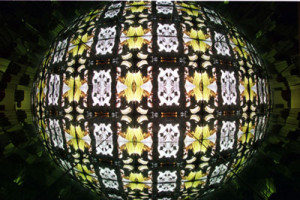
Theo Eshetu – Dutch Ethiopian – is one of the artists in the Kochi Muziris Biennial in India. Until March 29, 2015.
Brave New World II, 1999-2000.
About:
 Trip to Mount Zuqualla, 2005, video installation.
Trip to Mount Zuqualla, 2005, video installation.
C&: In some major parts of your body of work, the trajectories between Italy and Ethiopia as well as between past and present seem to be a recurrent theme. Why is that?
TE: Actually I make these connections because I’m from Ethiopia and I live in Italy. Then too, the two countries have a history together. To me, it’s more of a personal thing. If I were living somewhere else, my links would be with somewhere else. For me, Italy is the place where I’ve lived, where I grew up professionally. So I’m very influenced by Italian art. I went there from London because I loved Italian filmmakers, and the Renaissance artists, and the beauty. Then, of course, once you start looking at the history, you also start looking behind that façade of beauty. I have made several videos on Ethiopia already. When I started in the ’80s, I was making videos about African–European relationships that were mainly aesthetically based. Because that’s in my DNA: I’m half African, I’m half European. That dialogue between those two worlds is an integral part of me, whether it has historically been positive or negative. So when I was making videos, Africa and Europe were both metaphorical spaces. But at a certain point, I wanted to go to the real Ethiopia in order to make a film about the relationship between actual experience and childhood memory. So in 1997 I made a film about my grandfather, who was a well-known historian. That’s when I started getting interested in my Ethiopian origins and the country’s history. It all started with very personal events.
 Kiss the Moment, 2013, video installation.
Kiss the Moment, 2013, video installation.
C&: You have recently shown your installation “The Return of the Axum Obelisk” in Berlin. Can you talk about the work a little bit, how it started… why it challenged you to work on that topic?
TE: My father was working at the FAO (Food and Agriculture Organization) office where the Axum-Obelisk was standing. It is an object I’ve known since my childhood. As I started getting interested in Ethiopian history, that’s when rumors of its return began. I wasn’t only interested in it from a political point of view, but also from a personal one. It was a piece of Ethiopia that was in Rome. So this piece of Ethiopia that was going back to Ethiopia was for me almost the way that I felt. I was living in Europe and at the same time I was going back to Africa, and in particular to Ethiopia. In a way, if you look at history through the lens of biography and personal experience, you get a very different picture from official historical records. The complexity of history is that it is not factual. It’s clear to me that, for example, my installation is very political, but the politics are inside the work. They’re not on the surface. The politics are implicit in the object. I mean the two countries and their relationship; the politics are implicit.
 Return of the Exum Obelisk, 2009.
Return of the Exum Obelisk, 2009.
C&: It relies heavily on traditional Ethiopian myths, stories, and rituals, loaded with quite a bit of symbolism. In light of that, you also use video and technology. How did you bring all of those sources together?
TE: That’s also a part of the history. I’m interested in rituals and symbols; I’m interested in them from a symbolic point of view. You look at the obelisk as a symbol, and you define the return of it as a symbolic gesture. My interest in history goes back to pre-history. And it all begins with ritual. And nowadays there are still symbolic gestures, for instance, giving someone a present. We don’t think about it as a ritual. But it is a ritualistic gesture. And I think that a lot of the politics are totally impregnated with rituality. If you look at things as a ritualized relationship, I think you can understand the complexity better.
(from Contemporary &, October 2014)

